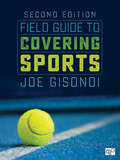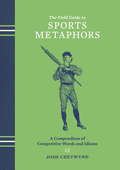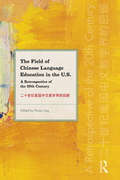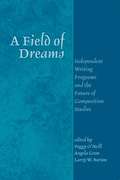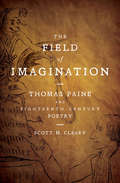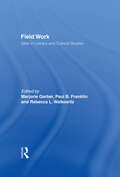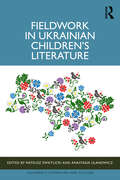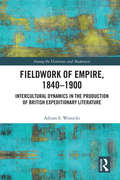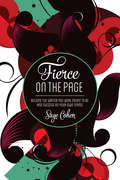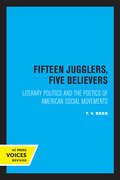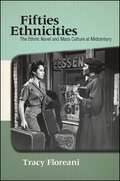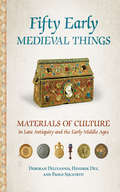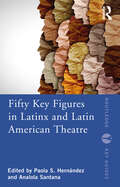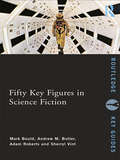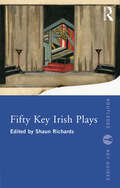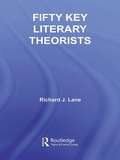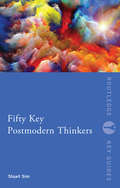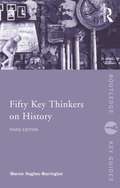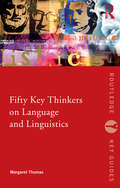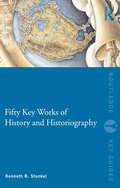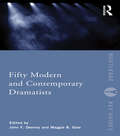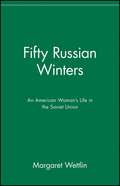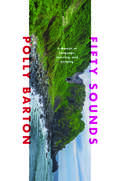- Table View
- List View
Field Guide to Covering Sports
by Joe GisondiTransform yourself from sports fan to professional sports journalist Field Guide to Covering Sports, Second Edition goes beyond general guidance about sports writing, offering readers practical advice on covering 20 specific sports. From auto racing to wrestling, author Joe Gisondi gives tips on the seemingly straightforward—like where to stand on the sideline and how to identify a key player—along with the more specialized—such as figuring out shot selection in lacrosse and understanding a coxswain’s call for a harder stroke in rowing. In the new Second Edition, readers also explore sports reporting across multimedia platforms, developing a foundational understanding for social media, mobile media, visual storytelling, writing for television and radio, and applying sabermetrics. Fully revised with new examples and updated information to give readers confidence in covering just about any game, match, meet, race, regatta or tournament, Field Guide to Covering Sports, Second Edition is the ideal go-to resource to have on hand when mastering the beat.
A Field Guide to Narnia
by Colin DuriezFrom the Book jacket: Whether this is your first visit or you've been there many times, you'll want to bring along this handy guide to the landscape and inhabitants of Narnia. You'll learn more about the mind behind Narnia, how Narnia relates to other imaginative worlds and children's literature, the history within the stories of Narnia, and how Narnia fits into Lewis's other work. This book will help you dig deeper into the series and its implications for understanding the Christian life. "Colin Duriez . . . provides profound insight into the brilliant mind and prolific writings of C. S. Lewis. By carefully interweaving the life experiences of Lewis with an analysis of his vast body of scholarly and popular works-especially his Chronicles of Narnia- Mr. Duriez provides the reader with new understanding and a strong motivation to read the works again and again."
The Field Guide to Sports Metaphors: A Compendium of Competitive Words and Idioms
by Josh ChetwyndA gift-worthy playbook of common and unexpected words and idioms that have their roots in sports and games. There are many metaphors we can quickly identify from the realm of sports: covering all the bases (baseball), game plan (football), and par for the course (golf). But the English language is also peppered with the not-so-obvious influence of sports and games, such as go-to guy (basketball) and dead ringer (horse racing). Filled with pithy entries on each idiom, plus quotes showing how big talkers from President Obama to rapper Ice-T use them, this quirky little handbook from former minor league ballplayer and award-winning journalist Josh Chetwynd is sure to be a conversation starter at tailgates, cocktail parties, and in the boardroom.From the Hardcover edition.
The Field of Chinese Language Education in the U.S.: A Retrospective of the 20th Century
by Vivian LingThis book will be the first account of the development of Chinese as a foreign language in the U.S., as it interacts with the relevant entities in China and beyond. There are virtually no systematic retrospective reflections on the field outside of the greater China region; and yet over the past decades the field has grown by leaps and bounds, and it is critical now that we pause to reflect on what has happened and what we can learn from the past. The contributors are among some of the most influential pioneers in the field whose entire academic lives have been dedicated to its development. The Field of Chinese Language Education in the U.S.: A Retrospective of the 20th Century is aimed at those who are currently engaged in Chinese language education, as teachers or as students.
Field Of Dreams: Independent Writing Programs And The Future Of Composition Studies
by Peggy O'NeillOne of the first collections to focus on independent writing programs, A Field of Dreams offers a complex picture of the experience of the stand-alone. Included here are narratives of individual programs from a wide range of institutions, exploring such issues as what institutional issues led to their independence, how independence solved or created administrative problems, how it changed the culture of the writing program and faculty sense of purpose, success, or failure. Further chapters build larger ideas about the advantages and disadvantages of stand-alone status, covering labor issues, promotion/tenure issues, institutional politics, and others. A retrospective on the famous controversy at Minnesota is included, along with a look at the long-established independent programs at Harvard and Syracuse. Finally, the book considers disciplinary questions raised by the growth of stand-alone programs. Authors here respond with critique and reflection to ideas raised by other chapters—do current independent models inadvertently diminish the influence of rhetoric and composition scholarship? Do they tend to ignore the outward movement of literacy toward technology? Can they be structured to enhance interdisciplinary or writing-across-the-curriculum efforts? Can independent programs play a more influential role in the university than they do from the English department?
The Field of Imagination: Thomas Paine and Eighteenth-Century Poetry
by Scott M. ClearyOne of America’s Founding Fathers, Thomas Paine is best remembered as the pamphleteer who inspired the American Revolution. Yet few also know him as an eighteenth-century poet of considerable repute. In The Field of Imagination, Scott Cleary offers the first book on Paine’s poetry, exploring how poetry written both by and about Paine is central to understanding his development as a political theorist.Despite his claim in The Age of Reason that he was abandoning poetry because it led too much into the "field of imagination," Paine never completely left poetry behind. He took advantage of his position as editor of the Pennsylvania Magazine to situate his poetry in relation to the magazine’s tacit support of American independence. He drew on two British poets, James Thomson and Charles Churchill, to provide revealing epigraphs for his major early works in support of that independence, and in turn he himself became an influence on early American poets such as Joel Barlow and Philip Freneau.Paine’s poetry has until now been largely relegated to the status of scholarly curiosity. But whether through his own poetry, his thoughts on the place and function of poetry in the Age of Reason, or his deep influence on the poetry of the early American republic, Paine’s involvement in poetical craft provides a lens onto the unique and tempestuous literary culture of the eighteenth century.
Field Trips: Out and About at the Newspaper
by Kitty Shea Jill Kalz Zachary TroverA group of children go on a field trip for a guided tour of a newspaper, where they learn how reporters, photographers, and other staff members work together to publish a newspaper. Includes an activity.
Field Work: Sites in Literary and Cultural Studies (CultureWork: A Book Series from the Center for Literacy and Cultural Studies at Harvard)
by Marjorie Garber Rebecca L. Walkowitz Paul B. FranklinFirst published in 1996. Routledge is an imprint of Taylor & Francis, an informa company.
Fieldwork in Ukrainian Children’s Literature (Children's Literature and Culture)
by Świetlicki, Edited by MateuszFieldwork in Ukrainian Children’s Literature showcases the work of prominent scholars of children’s literature from Ukraine and the diaspora as it traces the history of books written, marketed for, and circulating among young people since the rise of Ukraine’s nationhood in the nineteenth century. This book encompasses a full range of texts and genres (e.g., fiction, nonfiction, poetry, picturebooks, graphic novels), with special attention given to the most important authors and works as defined by aesthetics (“literary excellence”), popularity, or historical and cultural significance. In its focus on ideology and historical context, the collection takes an interdisciplinary and transnational approach. It places titles and trends in broader context, considering the socio-political situation, changing taste, and the history of institutions that shape the production and reception of children’s literature. The collection addresses folklore and the beginnings of a distinct tradition of Ukrainian children’s literature produced in the nineteenth century; the role played by children’s literature in the maintenance of the Ukrainian literary tradition during the Soviet era; and the flourishing Ukrainian book market, with the appearance of numerous new genres and forms, and the growing significance of Ukrainian books around the world. The collection highlights the importance of familiarizing non-Ukrainian students and scholars of children’s literature with the richness of the country’s literary history and cultural distinctiveness. Fieldwork in Ukrainian Children’s Literature is intended primarily for scholars of children’s literature and culture, including specialists in the fields of literary studies, education, and Slavic studies.
Fieldwork of Empire, 1840-1900: Intercultural Dynamics in the Production of British Expeditionary Literature (Among the Victorians and Modernists)
by Adrian S. WisnickiFieldwork of Empire, 1840-1900: Intercultural Dynamics in the Production of British Expeditionary Literature examines the impact of non-western cultural, political, and social forces and agencies on the production of British expeditionary literature; it is a project of recovery. The book argues that such non-western impact was considerable, that it shaped the discursive and material dimensions of expeditionary literature, and that the impact extends to diverse materials from the expeditionary archive at a scale and depth that critics have previously not acknowledged. The focus of the study falls on Victorian expeditionary literature related to Africa, a continent of accelerating British imperial interest in the nineteenth century, but the study’s findings have the potential to inform scholarship on European expeditionary, imperial, and colonial literature from a wide variety of periods and locations. The book’s analysis is illustrative, not comprehensive. Each chapter targets intercultural encounters and expeditionary literature associated with a specific time period and African region or location. The book suggests that future scholarship – especially in areas such as expeditionary history, geography, cartography, travel writing studies, and book history – needs to adopt much more of a localized, non-western focus if it is to offer a full account of the production of expeditionary discourse and literature.
Fierce on The Page: Become the Writer You Were Meant to Be and Succeed on Your Own Terms
by Sage CohenProduce your best work. Live your best life. Make your greatest impact. You have everything you need--and you are everything you need--to do the writing you are meant to do. And yet the path to success can be difficult to find and follow. Veteran author and writing guide Sage Cohen believes that ferocity is your best compass for finding your true way forward. She shows you how to transform your attitude and practices so you can:Unleash your creativityCultivate your strengthsOvercome resistance, fear, and other obstaclesDefine success on your own termsMove intentionally toward your goalsBecome unstoppable in your evolutionIn this collection of contemplative and inspiring essays, you'll unlock the secrets to naming your deepest desires, eliminating the challenges that hold you back, and committing to your practice. Fierce on the Page is your trustworthy companion for crafting your best writing and your best life. Join the conversation about the fierce writing life at fierceonthepage.com.
Fifteen Jugglers, Five Believers: Literary Politics and the Poetics of American Social Movements (The New Historicism: Studies in Cultural Poetics #22)
by T. V. ReedT. V. Reed urges an affiliation between literary theory and political action—and between political action and literary theory. What can the "new literary theory" learn from "new social movements," and what can social activists learn from poststructuralism, new historicism, feminist theory, and neomarxism? In striking interpretations of texts in four different genres—James Agee and Walker Evans’s Let Us Now Praise Famous Men, Ralph Ellison's Invisible Man, Norman Mailer's Armies of the Night, and the ecofeminist Women's Pentagon Actions of the early 1980s—Reed shows how reading literary texts for their political strategies and reading political movements as texts can help us overcome certain rhetorical traps that have undermined American efforts to combat racism, sexism, and economic inequality. This title is part of UC Press's Voices Revived program, which commemorates University of California Press’s mission to seek out and cultivate the brightest minds and give them voice, reach, and impact. Drawing on a backlist dating to 1893, Voices Revived makes high-quality, peer-reviewed scholarship accessible once again using print-on-demand technology. This title was originally published in 1992.
Fifties Ethnicities: The Ethnic Novel and Mass Culture at Midcentury (SUNY series in Multiethnic Literatures)
by Tracy FloreaniFifties Ethnicities brings together a variety of texts to explore what it meant to be American in the middle of "America's Century." In a series of comparative readings that draws on novels, television programs, movie magazines, and films, Tracy Floreani crosses generic boundaries to show how literature and mass media worked to mold concepts of ethnicity in the 1950s. Revisiting well-known novels of the period, such as Vladimir Nabokov's Lolita and Ralph Ellison's Invisible Man, as well as less-studied works, such as William Saroyan's Rock Wagram and C. Y. Lee's The Flower Drum Song (the original source of the more famous Rodgers and Hammerstein musical), Floreani investigates how the writing of ethnic identity called into question the ways in which signifiers of Americanness also inherently privileged whiteness. By putting these novels into conversation with popular media narratives such as I Love Lucy, the author offers an in-depth examination of the boundaries and possibilities for participating in American culture in an era that greatly influenced national ideas about identity. While midcentury mass media presented an undeniably engaging vision of American success, national belonging, and guidelines for cultural citizenship, Floreani argues that minority writers and artists were, at the same time, engaging that vision and implicitly participating in its construction.
Fifty Early Medieval Things: Materials of Culture in Late Antiquity and the Early Middle Ages
by Deborah Deliyannis Hendrik Dey Paolo SquatritiFifty Early Medieval Things introduces readers to the material culture of late antique and early medieval Europe, north Africa, and western Asia. Ranging from Iran to Ireland and from Sweden to Tunisia, Deborah Deliyannis, Hendrik Dey, and Paolo Squatriti present fifty objects—artifacts, structures, and archaeological features—created between the fourth and eleventh centuries, an ostensibly "Dark Age" whose cultural richness and complexity is often underappreciated. Each thing introduces important themes in the social, political, cultural, religious, and economic history of the postclassical era. Some of the things, like a simple ard (plow) unearthed in Germany, illustrate changing cultural and technological horizons in the immediate aftermath of Rome's collapse; others, like the Arabic coin found in a Viking burial mound, indicate the interconnectedness of cultures in this period. Objects such as the Book of Kells and the palace-city of Anjar in present-day Jordan represent significant artistic and cultural achievements; more quotidian items (a bone comb, an oil lamp, a handful of chestnuts) belong to the material culture of everyday life. In their thing-by-thing descriptions, the authors connect each object to both specific local conditions and to the broader influences that shaped the first millennium AD, and also explore their use in modern scholarly interpretations, with suggestions for further reading. Lavishly illustrated and engagingly written, Fifty Early Medieval Things demonstrates how to read objects in ways that make the distant past understandable and approachable.
Fifty Key Figures in LatinX and Latin American Theatre (Routledge Key Guides)
by Paola S HernándezFifty Key Figures in Latinx and Latin American Theatre is a critical introduction to the most influential and innovative theatre practitioners in the Americas, all of whom have been pioneers in changing the field. The chosen artists work through political, racial, gender, class, and geographical divides to expand our understanding of Latin American and Latinx theatre while at the same time offering a space to discuss contested nationalities and histories. Each entry considers the artist’s or collective’s body of work in its historical, cultural, and political context and provides a brief biography and suggestions for further reading. The volume covers artists from the present day to the 1960s—the emergence of a modern theatre that was concerned with Latinx and Latin American themes distancing themselves from an European approach. A deep and enriching resource for the classroom and individual study, this is the first book that any student of Latinx and Latin American theatre should read.
Fifty Key Figures in Science Fiction (Routledge Key Guides)
by Mark Bould Andrew M. Butler Adam Roberts Sherryl VintFifty Key Figures in Science Fiction is a collection of engaging essays on some of the most significant figures who have shaped and defined the genre. Diverse groups within the science fiction community are represented, from novelists and film makers to comic book and television writers. Important and influential names discussed include: Octavia Butler George Lucas Robert Heinlein Gene Roddenberry Stan Lee Ursula K. Le Guin H.G. Wells This outstanding reference guide charts the rich and varied landscape of science fiction and includes helpful and up-to-date lists of further reading at the end of each entry. Available in an easy to use A-Z format, Fifty Key Figures in Science Fiction will be of interest to students of Literature, Film Studies, and Cultural Studies.
Fifty Key Irish Plays (Routledge Key Guides)
by Shaun RichardsFifty Key Irish Plays charts the progression of modern Irish drama from Dion Boucicault’s entry on to the global stage of the Irish diaspora to the contemporary dramas created by the experiences of the New Irish. Each chapter provides a brief plot outline along with informed analysis and, alert to the cultural and critical context of each play, an account of the key roles that they played in the developing story of Irish drama. While the core of the collection is based on the critical canon, including work by J. M. Synge, Lady Gregory, Teresa Deevy, and Brian Friel, plays such as Tom Mac Intyre’s The Great Hunger and ANU Productions’ Laundry, which illuminate routes away from the mainstream, are also included. With a focus on the development of form as well as theme, the collection guides the reader to an informed overview of Irish theatre via succinct and insightful essays by an international team of academics. This invaluable collection will be of particular interest to undergraduate students of theatre and performance studies and to lay readers looking to expand their appreciation of Irish drama.
Fifty Key Literary Theorists (Routledge Key Guides)
by Richard J. LaneCovering over a century's worth of debate, thinking and writing about literature, this is a unique guide to the lives and works of fifty theorists who have left an indelible mark on literary studies. Featuring theorists such as Judith Butler, Jacques Derrida, Sigmund Freud and Edward Said, this accessible guide includes: a glossary of terms full cross-referencing for maximum ease of use authoritative guides to further reading on and by each theorist. An essential resource for all students of literature, Fifty Key Literary Theorists explores the gamut of critical debate, from the New Critics to the Deconstructionists, and from post-colonialism to post-Marxism and more.
Fifty Key Postmodern Thinkers: Fifty Key Postmodern Thinkers (Routledge Key Guides)
by Stuart SimPostmodernism is an important part of the cultural landscape which continues to evolve, yet the ideas and theories surrounding the subject can be diverse and difficult to understand. Fifty Postmodern Thinkers critically examines the work of fifty of the most important theorists within the postmodern movement who have defined and shaped the field, bringing together their key ideas in an accessible format. Drawing on figures from a wide range of subject areas including literature, cultural theory, philosophy, sociology and architecture those covered include: John Barth Umberto Eco Slavoj Zizek Cindy Sherman John Cage Jean-Francois Lyotard Charles Jencks Jacques Derrida Homi K. Bhabha Quentin Tarantino Each entry examines the thinkers’ career, key contributions and theories and refers to their major works. A valuable resource for those studying postmodern ideas at both undergraduate and postgraduate level, this text will appeal across the humanities and social sciences.
Fifty Key Thinkers on History (Routledge Key Guides)
by Marnie Hughes-WarringtonFifty Key Thinkers on History is an essential guide to the most influential historians, theorists and philosophers of history. The entries offer comprehensive coverage of the long history of historiography ranging from ancient China, Greece and Rome, through the Middle Ages to the contemporary world. This third edition has been updated throughout and features new entries on Machiavelli, Ranajit Guha, William McNeil and Niall Ferguson. Other thinkers who are introduced include: Herodotus Bede Ibn Khaldun E. H. Carr Fernand Braudel Eric Hobsbawm Michel Foucault Edward Gibbon Each clear and concise essay offers a brief biographical introduction; a summary and discussion of each thinker’s approach to history and how others have engaged with it; a list of their major works and a list of resources for further study.
Fifty Key Thinkers on Language and Linguistics (Routledge Key Guides)
by Margaret ThomasWhat was the first language, and where did it come from? Do all languages have properties in common? What is the relationship of language to thought? Fifty Key Thinkers on Language and Linguistics explores how fifty of the most influential figures in the field have asked and have responded to classic questions about language. Each entry includes a discussion of the person’s life, work and ideas as well as the historical context and an analysis of his or her lasting contributions. Thinkers include: Aristotle Samuel Johnson Friedrich Max Müller Ferdinand de Saussure Joseph H. Greenberg Noam Chomsky Fully cross-referenced and with useful guides to further reading, this is an ideal introduction to the thinkers who have had a significant impact on the subject of Language and Linguistics.
Fifty Key Works of History and Historiography (Routledge Key Guides)
by Kenneth R. StunkelFifty Key Works of History and Historiography introduces some of the most important works ever written by those who have sought to understand, capture, query and interpret the past. The works covered include texts from ancient times to the present day and from different cultural traditions ensuring a wide variety of schools, methods and ideas are introduced. Each of the fifty texts represents at least one of six broad categories: early examples of historiography (e.g. Herodotus and Augustine) non-western works (e.g. Shaddad and Fukuzawa) ‘Critical’ historiography (e.g. Mabillon and Ranke) history of minorities, neglected groups or subjects (e.g. Said and Needham) broad sweeps of history (e.g. Mumford and Hofstadter) problematic or unconventional historiography (e.g. Foucault and White). Each of the key works is introduced in a short essay written in a lively and engaging style which provides the ideal preparation for reading the text itself. Complete with a substantial introduction to the field, this book is the perfect starting point for anyone new to the study of history or historiography.
Fifty Modern and Contemporary Dramatists (Routledge Key Guides)
by Maggie B. Gale John F. DeeneyFifty Modern and Contemporary and Dramatists is a critical introduction to the work of some of the most important and influential playwrights from the 1950s to the present day. The figures chosen are among the most widely studied by students of drama, theatre and literature and include such celebrated writers as: • Samuel Beckett • Caryl Churchill • Anna Deavere Smith • Jean Genet • Sarah Kane • Heiner Müller • Arthur Miller • Harold Pinter • Sam Shephard Each short essay is written by one of an international team of academic experts and offers a detailed analysis of the playwright’s key works and career. The introduction provides an historical and theatrical context to the volume, which provides an invaluable overview of modern and contemporary drama.
Fifty Russian Winters: An American Woman's Life in the Soviet Union
by Margaret WettlinFIFTY RUSSIAN WINTERS In 1932 Margaret Wettlin left Depression-torn America for the Soviet Union, eager to see for herself if communism was the hope for the future. Planning to remain one year, she fell in love with and married stage director Andrei Efremoff, and stayed on for almost fifty years. This extraordinary memoir is the story of how she and her family-and millions of their fellow citizens-struggled to survive the hardships of famine, repression, war, and terrible purges. Fifty Russian Winters is an incomparable and moving document-the only close-up view we have of Soviet life by an American who spent more than half a lifetime inside Russia and who, as Harrison Salisbury says in his introduction, "kept her heart and mind and eyes open-and remembered."
Fifty Sounds: A Memoir of Language, Learning, and Longing
by Polly BartonFor anyone who has ever yearned to master a new language, Fifty Sounds is a visionary personal account and an indispensable resource for learning to think beyond your mother tongue. “The language learning I want to talk about is sensory bombardment. It is a possession, a bedevilment, a physical takeover,” writes Polly Barton in her eloquent treatise on this profoundly humbling and gratifying act. Shortly before graduating with a degree in philosophy from the University of Cambridge, Barton on a whim accepted an English-teaching position in Japan. With the characteristic ambivalence of a twenty-one-year-old whose summer—and life—stretched out almost infinitely before her, she moved to a remote island in the Sea of Japan, unaware that this journey would come to define not only her career but her very understanding of her own identity. Divided into fifty onomatopoeic Japanese phrases, Fifty Sounds recounts Barton’s path to becoming a literary translator fluent in an incredibly difficult vernacular. From “min-min,” the sound of air screaming, to “jin-jin,” the sound of being touched for the first time, Barton analyzes these and countless other foreign sounds and phrases as a means of reflecting on various cultural attitudes, including the nuances of conformity and the challenges of being an outsider in what many consider a hermetically sealed society. In a tour-de-force of lyrical, playful prose, Barton recalls the stifling humidity that first greeted her on the island along with the incessant hum of peculiar new noises. As Barton taught English to inquisitive middle school children, she studied the basics of Japanese in an inverse way, beginning with simple nouns and phrases, such as “cat,” “dog,” and “Hello, my name is.” But when it came to surrounding herself in the culture, simply mastering the basics wasn’t enough. Japanese, Barton learned, has three scripts: the phonetic katakana and hiragana (collectively known as kana) and kanji (characters of Chinese origin). Despite her months-long immersion in the language, a word would occasionally produce a sinking feeling and send her sifting through her dictionaries to find the exact meaning. But this is precisely how Barton has come to define language learning: “It is the always-bruised but ever-renewing desire to draw close: to a person, a territory, a culture, an idea, an indefinable feeling.” Engaging and penetrating, Fifty Sounds chronicles everything from Barton’s most hilarious misinterpretations to her new friends and lovers in Tokyo —and even the influence of Ludwig Wittgenstein’s transformative philosophy. A classic in the making in the tradition of Anne Carson and Rachel Cusk, Fifty Sounds is a celebration of the empowering act of learning to communicate in any new language.
